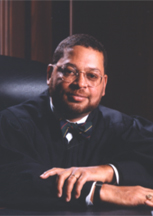A non-profit conservation group recently launched a first-of-its-kind tool for measuring the environmental impact of Michigan Supreme Court decisions.

Red, yellow and green gavels illustrate the negative, neutral or positive conservation impact of each environmental case that reaches the Michigan Supreme Court.
Green Gavels uses red, yellow and green gavels to illustrate the negative, neutral or positive conservation impact of each environmental case that reaches the Michigan Supreme Court.
The group heading the project, Michigan League of Conservation Voters, also rates each justice’s decision in each case. People can see if a specific justice’s voting patterns has a negative or positive environmental impact overall.
“Our mission is to provide the information necessary for citizens to hold officials accountable,” said Drew YoungeDyke, the league’s policy and communications specialist. “The Michigan Supreme Court is an elected position and with the Supreme Court in particular, many citizens know nothing about it.”
Under the guidance of David Uhlmann, director of the Environmental Law and Policy Program at the University of Michigan, law students researched and wrote objective summaries for every environmental case that went to the court in the past 30 years.
League of Conservation Voters attorneys assign initial gavel ratings based on the organization’s guidelines. Then they hold an advisory panel to review all the ratings and make sure that they’re in line with legal standards.
“There are actually very few environmental cases per year, but the ones that do come up have a pretty significant impact.” YoungeDyke said.

Michael F. Cavanagh has a 15 green gavel rating. Photo: Michigan.gov.

Stephen J. Markman has a seven red gavel rating. Photo: Michigan.gov.

Robert P. Young, Jr. has a seven red gavel rating. Photo: Michigan.gov.
Of the seven justices in the Michigan Supreme Court, Robert P. Young, Jr. and Stephen J. Markman are tied at seven for the most red gavel ratings. Michael F. Cavanagh has the most green gavels at 15. The full list of rated cases is on the league’s website.
YoungeDyke acknowledges that the environmental impact of a case is not the court’s main concern. “Obviously the justices are basing their decisions on the facts before them and the laws they need to interpret. But we base it on the conservation impact,” he said.
Green Gavels is the league’s latest accountability program to follow environmental issues through state government.
The Michigan Environmental Scorecard tracks state legislators’ voting patterns back to 2001 on topics like natural resources protection and children’s health.
“When Gov. Rick Snyder took office, we launched the How Green is Your Governor? Program,” YoungeDyke said. “To make sure we are covering all the branches of government, we thought it was necessary for citizens to know how the Supreme Court is functioning.”
Knowing how the Supreme Court is functioning is imperative. Democracy at work! Thanks always to the efforts of Great Lakes Echo, Michigan State University Knight Center for Environmental Journalism.
Avid Reader,
Douglas A.DeVoid
Stephen J. Markman and Robert P. Young, Jr. were strongly supported by the NRA gun clubs of Michigan. The NRA is a anti-environmental organization supporting all the Republicans working to destroy the DNR and DEQ funding, which fits exactly the view of the right-wing Tea Party Michigan supreme court.